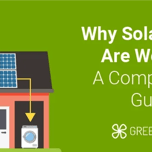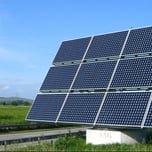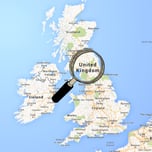Answer these simple questions and we will find you the BEST prices
Which type of solar quotes do you need?
It only takes 30 seconds
100% free with no obligation

Get up to 4 quotes by filling in only 1 quick form

Slash your energy bills by installing solar panels

For the average 2-3 bedroom house
- GreenMatch
- Solar Energy
- Solar Panels
- Flat Roof Solar Panels
Solar Panels on Flat Roofs: Costs, Pros & Cons (October 2025)

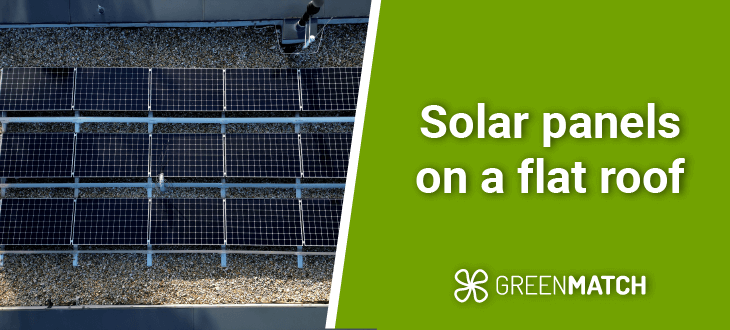
- Solar panels can be installed on flat roofs and are often easier to set up (depending on your roof, the space available, and its accessibility).
- Flat roof solar panels can cost between £2,800 - £12,100 for the average 2 to 3 bedroom house.
- Flat roof solar panels cost less in terms of labour costs since installation is easier (however this depends on your roof).
- One downside of putting solar panels on a flat roof is that they take up more space per kW.
When considering what type of roof is ideal for solar panels, many often consider pitched roofs as the only option. Homeowners also often ask “Can you have solar panels on a flat roof?”. In reality, flat roofs are just as viable and can bring many unique advantages, being easier to maintain and offering a simpler installation process. Let’s discuss the costs, benefits, and drawbacks of flat roof mounted solar panels.
If you’re wondering whether your roof is suitable for solar panels, the best thing to do is to contact a reliable professional. While this usually takes days of strenuous searching and calling up companies, our service can streamline the process to a 30-second form.
Click the button below and you can get up to 4 free, non-binding solar panel quotes from thoroughly vetted installers.
- Quotes from local engineers
- Payment by finance available
- Save up to £1,567 per year
It only takes 30 seconds



Can you put solar panels on a flat roof?
Yes, you can install solar panels on flat roofs. For these panels, it's important to leave sufficient spacing between the solar panel rows for access and to prevent shading from one row onto the next. While a flat angle may not be ideal for optimal energy generation, they can angled properly with the right equipment.
Solar panels can even be easier to maintain on a flat roof than on angled roofs. However, to maximize efficiency, you'll need a mounting system to tilt the panels towards the sun at the correct angle. They can also take up more space, requiring area for proper ventilation and preventing panels from shading each other. You can even install in roof solar panels on your flat roof.
It's important to remember that flat roofs can have disadvantages, such as minimal slope allowance, if you do not use an adjustable ballast or stand. They will also require more space per kW since solar panels on stands and ballasts need to be spaced out, as mentioned earlier.
Flat roof solar panel mounting is usually done with ballasts, which can also incur extra costs during purchase. Ballasts can be around £60 to £120 per kilowatt on average but prices can vary based on sizes and whether they offer “universal” mounting or only mount certain panel systems. They can also be quicker to install making them cheaper in terms of the installation labour costs.
With flat roofs, the installer has to set the pitch of the solar panels (typically between 30° to 50°, while the best orientation for solar panels in the UK is southward). This can be beneficial as it allows for optimal angling and positioning for your region. Another advantage of a solar panel installation on a flat roof is that the direction the roof faces plays a lesser role since there is more freedom to angle and position it.
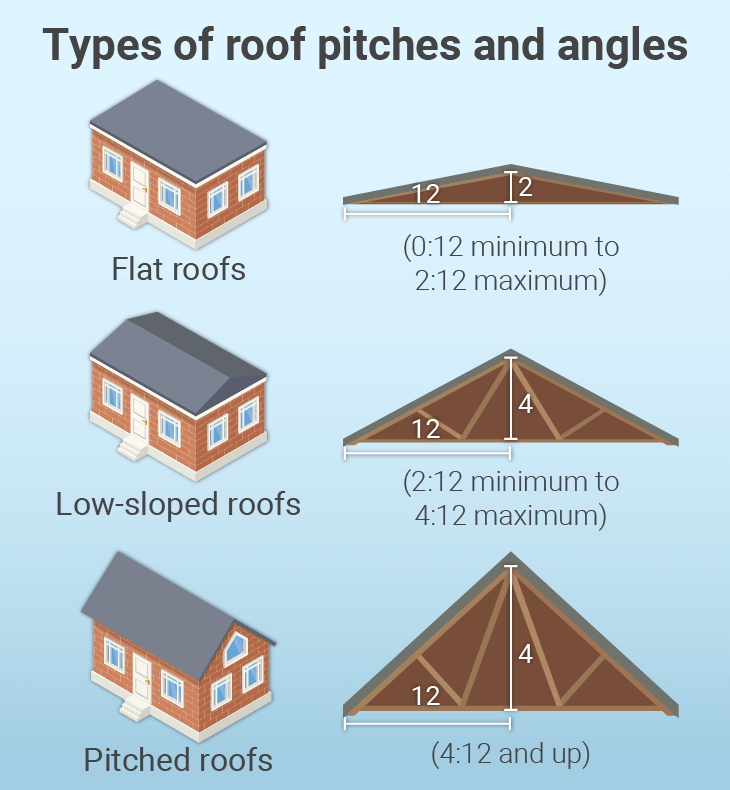
Aside from flat roofs, you can also have low-sloped roofs and pitched roofs. Each of these has its advantages and disadvantages.
Low-sloped roofs are common in the UK and can be used to install solar panels, although they may not always have the ideal angle for efficiency. A low slope is generally one where the pitch is between 4:12 and 2:12.
Low-sloped roofs require less roofing material per square foot making them easier and safer installation and repair processes. They can also offer better drainage than flat roofs. On the other hand, much like flat roofs, they can be more susceptible to issues with heavy snow. As a result, this could be hazardous to solar panel fixtures and less likely to clean on its own.
Pitched roofs still exist in the UK and have some pros and cons when it comes to installing solar panels. The slope angle brings about better run-off for debris, water, and snow making it easier for solar panels to stay clean on their own. There is a lower probability of water buildup, which can lead to leaks and mould damage.
However, the installation process, maintenance, and repair are more challenging due to the slope. Pitched roofs can also be less safe to install on and more expensive.
For different slopes/angles, here are the levels of sunlight capture for solar panels in the UK:
| Percentage of solar capture vs solar panel angles | |
|---|---|
| Solar panel angles | Solar energy capture |
| 0° (flatly placed solar panels) | 90% on average |
| 30° | 86% - 100% |
| 40° | 84% - 100% |
| 50° | 78% - 97% |
| 60° | 74% - 93% |
| 70° | 69% - 87% |
Note: 100% refers to the ideal amount that the panel can capture, and does not refer to efficiency.
Luckily, with adjustable ballasts, you can angle the panels however you want. This can also be great for adjusting them across the seasons as the sun changes position.
How much do flat roof solar panels cost?
For an average 2 to 3-bedroom house, flat roof solar panels cost between £2,800 and £12,100 on average when taking into account system costs and the cost of ballasts. The average home in the UK is usually a 2 or 3-bedroom house, which means that they can cover their electricity needs with a 3kW to 4kW system.
| Cost of flat roof solar panels | ||||
|---|---|---|---|---|
| Household size | System size | System cost | Ballast costs | Total cost |
| Small; 1-2 bedrooms | 2kW | £3,800 - £4,600 | £300 - £600 | £2,800 - £4,100 |
| Small; 1-2 bedrooms | 3kW | £5,700 - £7,000 | £420 - £840 | £4,920 - £5,840 |
| Medium; 2-3 bedrooms | 4kW | £6,600 - £8,100 | £600 - £1,200 | £5,600 - £7,200 |
| Medium; 2-3 bedrooms | 5kW | £8,300 - £10,200 | £720 - £1,440 | £8,250 - £8,940 |
| Large; 4-5 bedrooms | 6kW | £10,000 - £12,200 | £900 - £1,600 | £10,400 - £12,100 |
The prices above assume 400W to 450W panels per ballast.
Installing flat roof solar panels in the UK can potentially be less expensive as the process is usually easier, even with the added costs. This can depend on the number of panels and what type of mounting system. All in all, flat roofs provide stable footing for any installer and, with ballasts or other types of mounting systems, they can be quicker and thus require fewer man-hours.
The best solar panels for your home don’t necessarily have to be the most costly. They should primarily meet your home energy needs and fit your available roof space. If you have abundant roof space, you can opt for more low-power, low-cost panels and get a lower rate for the same overall system output.
Keep in mind that the costs above do not include additional components like solar battery storage systems (which we recommend). Similarly, these numbers are best adjusted for domestic use. For offices or other high-power buildings, you may want to consider commercial solar panels. You can also use our solar calculator to estimate potential solar panel costs, savings and payback time based on your home address.
How much can you save by installing solar panels for flat roofs
The average 2 to 3-bedroom house can save between £783 and £1,567 annually by installing solar panels. This is true of flat roofs and well as sloped roofs so there is no real difference between the savings of the two setups. The average home can expect to break even in 7 to 6 and can potentially save on labour costs, keeping their expenses on the lower end of the average price.
| Flat-roof solar panel savings | ||||
|---|---|---|---|---|
| Size | Cost | Household size | Annual savings/ household size | Break-even point |
| 2kW | £3,800 - £4,600 | 1-2 bedrooms | £783 | 7 |
| 3kW | £5,700 - £7,000 | 1-2 bedrooms | £783 | 7 |
| 4kW | £6,600 - £8,100 | 2-3 bedrooms | £1,304 | 6 |
| 5kW | £8,300 - £10,200 | 2-3 bedrooms | £1,304 | 6 |
| 6kW | £10,000 - £12,200 | 4-5 bedrooms | £1,567 | 6 |
Flat roof solar panels can be cheaper to install but this often depends on the person you hire. That’s why getting a reliable installer is the best way to keep costs down. While this can often take days of monotonous research, we can do the legwork for you with our network of thoroughly vetted installers.
Our service can provide you with up to 4 free, non-binding quotes and all you have to do is fill out a 30-second form. Click the button below to get started.
- Quotes from local engineers
- Payment by finance available
- Save up to £1,567 per year
It only takes 30 seconds



Pros and cons of flat roof solar panels
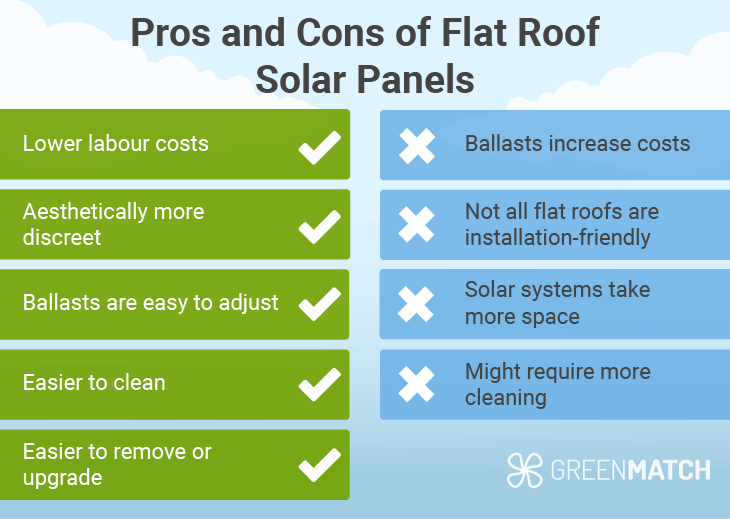
Pros:
- Lower labour costs: Mounting panels to brackets on a roof is less expensive and time-consuming than attaching panels to a sloped roof in most cases. This can decrease the labour costs for installing solar panels on a flat roof as it will require fewer man-hours and thus keep costs on the lower side of the prices per kW listed earlier.
- Aesthetically more discreet: Flat roofs allow for solar panels to be hidden from plain view. This can be advantageous to some homeowners who would prefer not to have them visible from the street.
- Ballasts are easy to adjust: Unlike attaching to a roof or integrating them into the building, PV flat roof mounting systems can be adjusted easily. This can be advantageous as you can alter the angle of your system seasonally for better efficiency as flat roofs are easier to access.
- Easier to clean: Rather than being integrated into the structure of the roof, flat solar panels are easy to clean under and around. Flat roofs are also easier to access and stand on which helps with cleaning and maintenance.
- Easier to remove or upgrade: With easier access, another advantage is that they will be cheaper to swap out and replace in case of system replacement or failure.
Cons:
- Ballasts increase costs: The purchase costs of additional stands and ballasts can add to the installation expenses.
- Not all flat roofs are installation-friendly: Finding a space suitable to install solar panels for flat roofs in the UK can require keeping drainage, vents, outdoor units, and other structures in mind. These may block space or obstruct sunlight. Solar panels for apartments can often require additional hurdles like solar panel planning permission.
- Solar systems take more space: Solar panels need to be spaced out more on flat roofs since they can overshadow each other if they are too close. This leads to each row of panels taking up comparatively more space.
- Might require more cleaning: With more areas where debris, dust, and other environmental hazards can get trapped, these types of installations may require more cleaning.
Find flat roof solar panel installers in your area
If you’re still wondering “Are solar panels worth it?”, you should consult a professional installer to determine whether your home is suitable for solar installation. Finding a reliable one can take an exhausting amount of time (often days of research), which is why our service can be a better alternative. With a simple 30-second form we can provide you with up to 4 free, non-binding quotes.
We’ve vetted all the installers in our network so you don’t have to go through the trouble of seeking out companies and comparing their rates. Click the button below to get started.
- Quotes from local engineers
- Payment by finance available
- Save up to £1,567 per year
It only takes 30 seconds



FAQ
Flat roofs can anchor solar panels with the help of ballasts which can be hooked onto roofs. However, you should check with an installer to determine whether your specific roof is suitable for panels.
Flat roofs make it easier to hide solar panels since they provide discreet positioning and obscure them from street view. The adjustability of ballasts and mounting systems is one of the many advantages of flat roof panels.
Solar panels resting on flat roofs are especially vulnerable to wind forces as they do not sit flush to the roof’s surface. This is why they should not be put close to the edge and should be mounted with strong ballasts.
In some situations, solar panels require planning permission. The need for planning permission can depend on your surrounding area, the region you live in, and what type of roof you have.
Solar panels on a flat roof in the UK should be at least 1 metre from the edge. Wind forces can be stronger at the edge which could affect the fastening of the panels. This is worth considering since flat roof solar panels take up more space.

Rawal Ahmed is a writer at GreenMatch with an interest in sustainability and a background in tech journalism and digital marketing.
We strive to connect our customers with the right product and supplier. Would you like to be part of GreenMatch?

- Quotes from local engineers
- Payment by finance available
- Save up to £1,567 per year
It only takes 30 seconds




